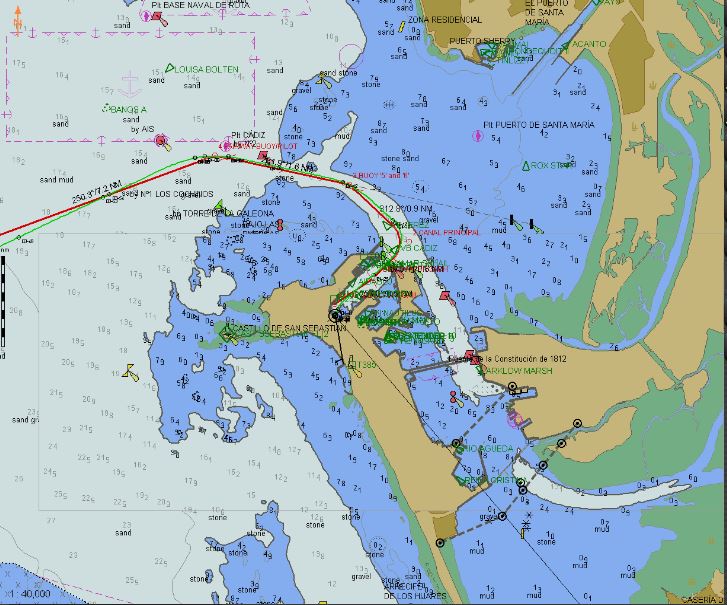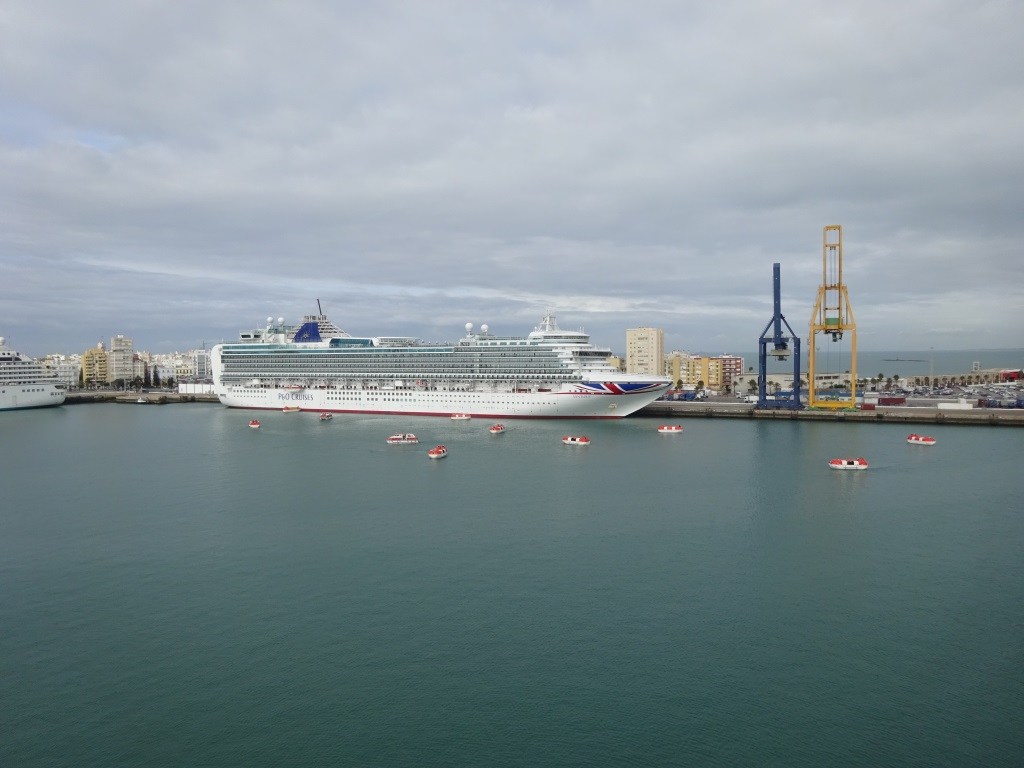Cadiz is the only Atlantic port we will visit during this cruise and to do that we had to poke our nose outside the Pillars of Hercules, with other words sail through the Straits of Gibraltar. From Ceuta it is not that far as you curve around the rock of Gibraltar and you are basically there. Getting into Cadiz takes a bit more doing as the port is hidden on the inside of the Cadiz peninsula which always gave the ships a good shelter against swell and Wind. The protection against the swell is still there, the wind is another story. The cruise ships are now that high, that they tower well above the port and nicely catch the wind that blows over the houses, churches and containers. Arrival in Cadiz can be a very windy affair and can cause some uncomfortable moments if you have to swing in the port and/or have to dock against the wind. While sailing in, you sail through a river estuary, which goes from being a fairly narrow river to a very wide delta before it meets the Ocean. As a result there is an enormous muddy area on both sides of the buoyed channel. The buoys are needed to indicate where the deep water is and you have to hug the red side as the green buoys are not on the edge of shallow water but quite a ways onto the mud flats. Most likely caused by sediments which settled in the curve of the river on the slow flowing side.

The port of Cadiz. Blue indicates shallow water and when we sail in and out we hug the red buoyed side of the channel.
The main port where the cruise ships and ferries dock is U shaped and normally the top north corner is used as a cruise ship berth as they have a little terminal there and it is the closest gate to walking into town. But Cadiz is a popular cruise port; a. for the city itself, b. for the easy way of getting to Seville by bus as that much larger city is only an hour away. There are days when there are 6 or 7 cruise ships in port and then the port is really full. Today there was some space left but there were still the three of us. (Plus a small river cruiser: the Belle of Cadiz) At the cruise terminal/dock was the Ventura of P&O cruises as she was the biggest one; then there was us and we were farmed out to the South side container dock and at the side center berth was the Crystal Serenity basically because she fitted in there. When I was captain on the Prinsendam and the S class ships that was my standard dock in Cadiz, as the ships fitted in nicely alongside. Also for the guests it was not a bad location as this dock is on top of the other main Gate.
For us it was a little more complicated today, we were further out on the cargo dock and thus the local authorities had a shuttle bus running to the Gate as walking on a cargo dock is never a good idea unless there is no work being done on a Sunday. Fork and container lift drivers are all convinced that they have to break the record time while racing from one part of the dock to the other part of the dock and they do not tend to pay much attention to the surrounding world while on their record attempting runs.
Most of our Guests were on tour either to Seville or to Cadiz and its surroundings but the few who remained on board were treated to a Boat drill show from the Ventura. All cruise ships have the same basic routine although the way we go about it might be different from company to company. Even for the ships inside the Carnival Corporation (of which Holland America and P&O Cruises are both a subsidiary) there are differences. Some caused by historical routines, some by legal circumstances, Dutch Flag State versus UK Flag State, and sometimes because somebody had a bright idea which the company implemented and what another company thought was not a bright idea at all. (You find that everywhere in the world, just compare the USA army, with the Russian Army or with the Chinese Army. They have guns, but all the guns are different and they all march different)

Boat drill, mother Goose with the little ducklings. As you can see about half are in a circular pattern, guarded by one tender and the rest has gone on exploration and has to be called back.
Today the Ventura held a General Boat drill or Abandon ship drill. Maritime Law or Solas law requires that every crew member will participate in at least one drill every month and that each life boat goes into the water at least every three months. How that is done is up to the Flag State and the individual company. Some company’s strictly follow the monthly / three monthly rule and some have a much higher frequency. As is the case with Holland America, were our boats normally are in the water about every 14 days. Most companies have a cycle of whereby the crew has one focused drill which involves them in detail and then a full ship drill when each has had their focused drill. So in 4 weeks, a lifeboat crew might be in the water with their boat twice in a month.
Lowering all the boats on one side at the same time requires a special routine so they do not bump into each other or land on top of each other when lowering. Once they are in the water, they are all supposed to sail in a semicircular parade until the Officer in charge calls them back one by one to come back under the falls and to be hoisted up again. That sailing in a circle does not always work. Most of the Lifeboat commanders are Hotel officers and Crew and their view on discipline does not always entail the same sort of circle as the Deck officer in charge had envisioned. Also the chance to go sightseeing with your own lifeboat in the port is a temptation that few lifeboat crews can withstand. Hence, and this is for all the ships regardless of company, we have a really lucky day if everybody sails nicely in the oblong circle and keeps doing that.
This evening we sail back into The Mediterranean and then head for Barcelona. As we have to go all the way around the south side of Spain, we will have a day at sea tomorrow while we hug the Spanish coast going eastwards.

October 12, 2018 at 9:51 pm
RE your note about buoys, I have a question. As a U.S. weekend sailor (for whom you always have such warm words) I learned red-right-return. In Europe that puts you in the mud or worse. Is there a story behind why buoy colors in the States is reverse from other parts of the world?
October 13, 2018 at 8:04 am
thank you for reading my blog.
North America has another Cardinal Buoyage system than Europe. Basically Red and green are at the other side. I am not an expert on this sort of history but the story goes when the USA went independent in 1776, or therefore, they decided to switch the buoy system around in the hope that those nefarious British ships would all run aground when trying to re-invade again.
Best regards
Capt. Albert
October 13, 2018 at 5:08 am
Hope to have the opportunity to hear your presentation on board. Enjoying your commentary as we visit these ports.